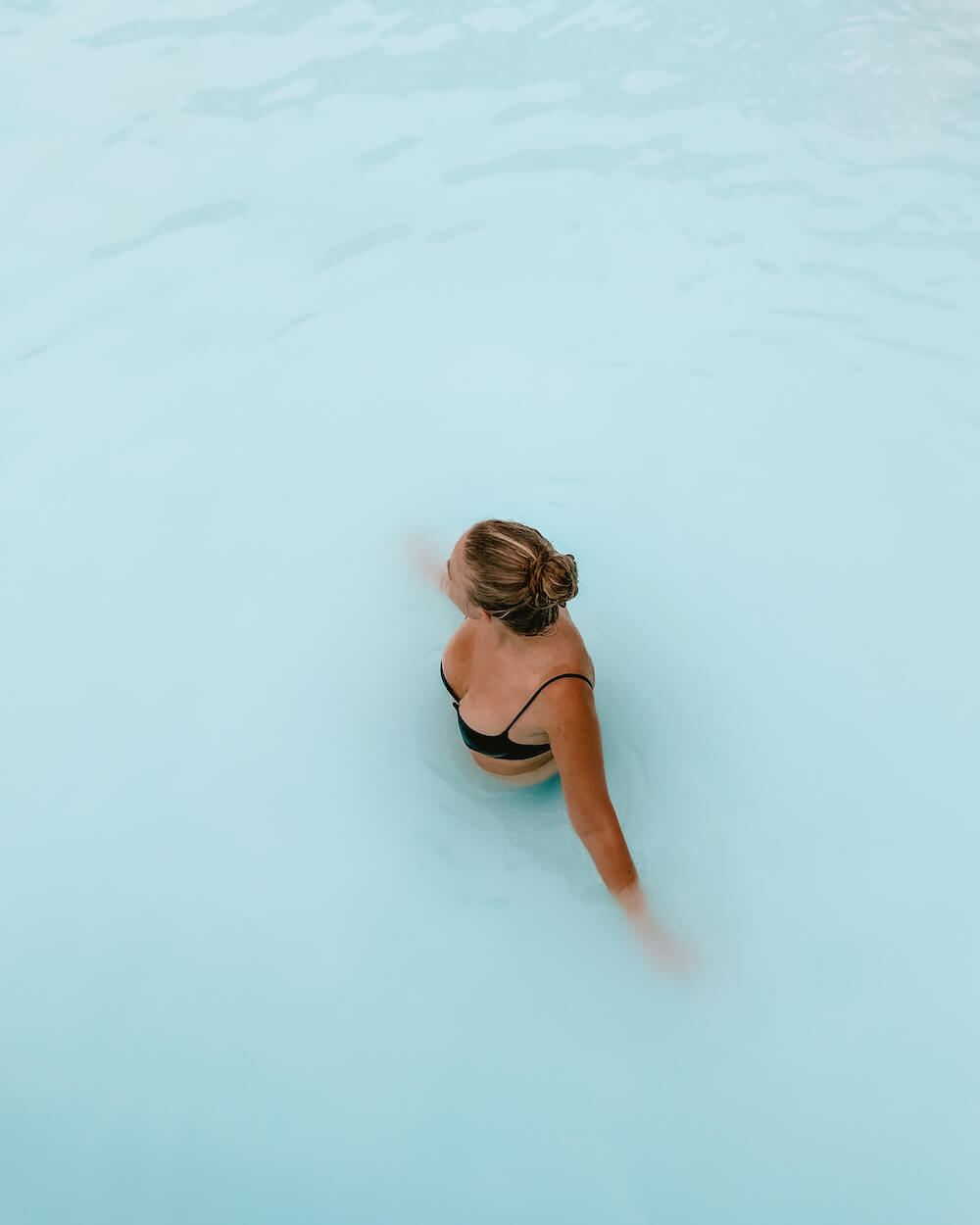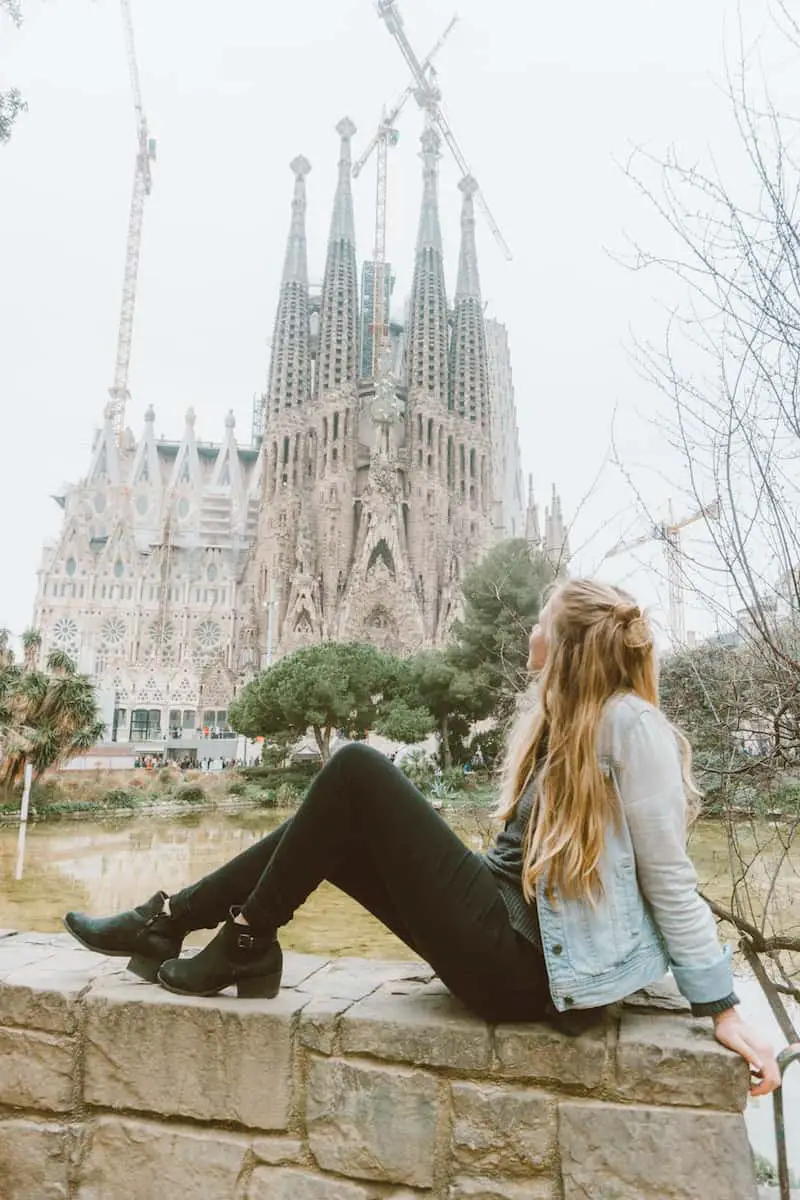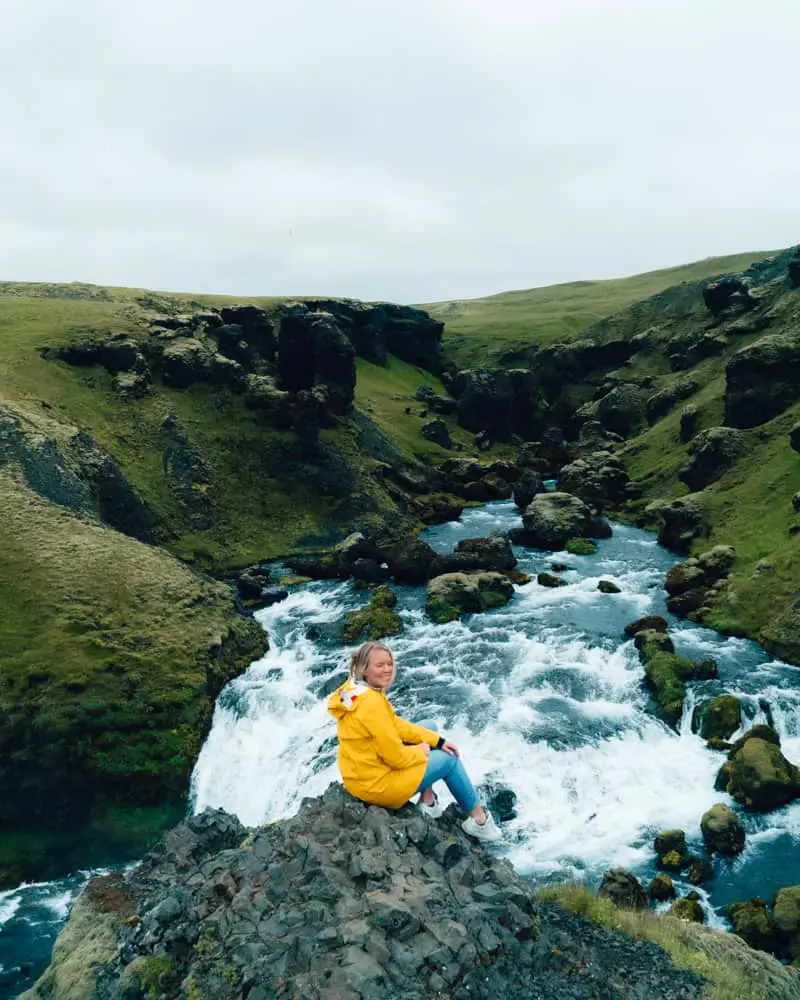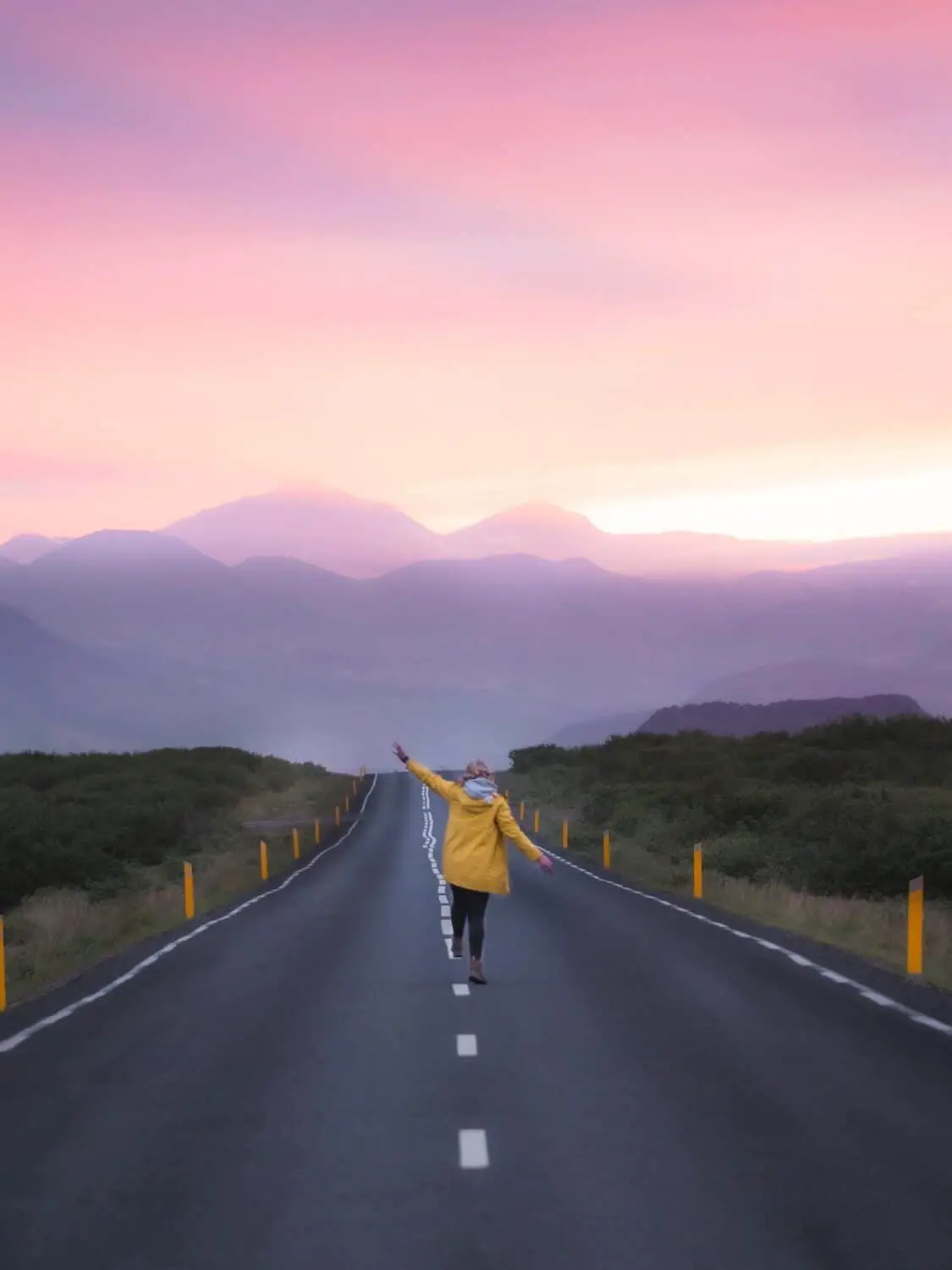7 Days In Iceland Itinerary: How To Spend One Epic Week In Iceland
Looking for the perfect itinerary for 7 days in Iceland? In this post, I’ll show you how to spend one week in Iceland, how much you can expect to spend, and some of my favorite free things to do in Iceland.
This post may contain affiliate links, which means I’ll receive a commission if you purchase through my link, at no extra cost to you.

Pssst: If you’re traveling right now, then you NEED to have good travel insurance. If the past few years have taught us anything, it’s that there’s no way to know what the future holds! With the risk of getting sick, quarantining, or travel plans getting messed up, it’s so important that you have travel insurance for every trip. I use and recommend Safety Wing travel insurance. They cover unexpected quarantine, treatment, travel delay, and much more. Check out their prices and more details here.
Is One Week Enough For Iceland?
One week is the perfect amount of time to visit Iceland. It will allow you to see lots of the most beautiful natural and cultural sights in the country. You’ll find that most of the popular attractions in Iceland are condensed into the Southern part of the country.
One week in Iceland is enough time to drive the ring road at a semi-accelerated place, but we preferred having a home base and taking day trips.
However, if you have longer, I definitely recommend spending 10 days to two weeks in Iceland. This will allow you to explore at a slower pace and see some of the less touristy attractions in the north.
How Much Does One Week In Iceland Cost?
You’ve probably heard that Iceland is an expensive place to visit. That can DEFINITELY be true (hello $15 hot dogs?), but it doesn’t have to be!
An average one week trip to Iceland should cost you between $700 to $1400 per person. This is an average of $100 to $200 per person per day.
As you can see, this is a wide range to account for different accommodation preferences, transportation methods, and amount of meals eaten out.
We spent one week in Iceland on a budget and we ended up spending way less than I thought we would.
We saved money by staying in an Airbnb the whole time, cooking all of our meals, and renting a very fuel-efficient car. We also found that most activities and attractions in Iceland were totally free to enjoy.
Here’s exactly what we spent in 7 days in Iceland. Note that this is per person for a group of four people.
- Airbnb: $262.77
- Car Rental: $206.25
- Groceries: $36
- Restaurants and cafes: $83.57
- Gas: $62.60
- Activities: $83.50
- Covid test to return home: $55.78
TOTAL COST: $790.47 per person for a week in Iceland.
Looking to travel Iceland on a budget? I have a post about 13 incredible FREE things to do in Iceland.
How To Spend One Week In Iceland
I’m going to start this one week in Iceland itinerary off by saying that we stayed in one place for the duration of our trip. We preferred taking day trips and having a home base to come back to at night.
This also helped us keep our accommodation and food costs down because we could cook most of our meals in our Airbnb.
If you want to see the pros and cons of doing this, I have a whole post about whether or not you should stay in one place in Iceland.
If you are planning on doing an Iceland road trip and staying in different locations each night, this may not be the itinerary for you.
But I’ll still give you tons of tips and places to see that you can add to your own itinerary so stick around!
Okay let’s get into our one week in Iceland itinerary:
Day 1 In Iceland: Blue Lagoon And Golden Circle Sights
Arrive In Iceland
On our first day in Iceland, we arrived at the airport at 6:40am. After clearing customs and grabbing our bags we grabbed the shuttle to the rental car facility.
We rented our car through the company Northbound. They had the cheapest rates, no hidden fees, and they even offered a car WiFi device for just a few dollars a day.
We paid $773.98 total for the 7 day car rental. This included CDW insurance, a 4G WiFi router, our shuttle to and from the airport, and a free additional driver.
Blue Lagoon
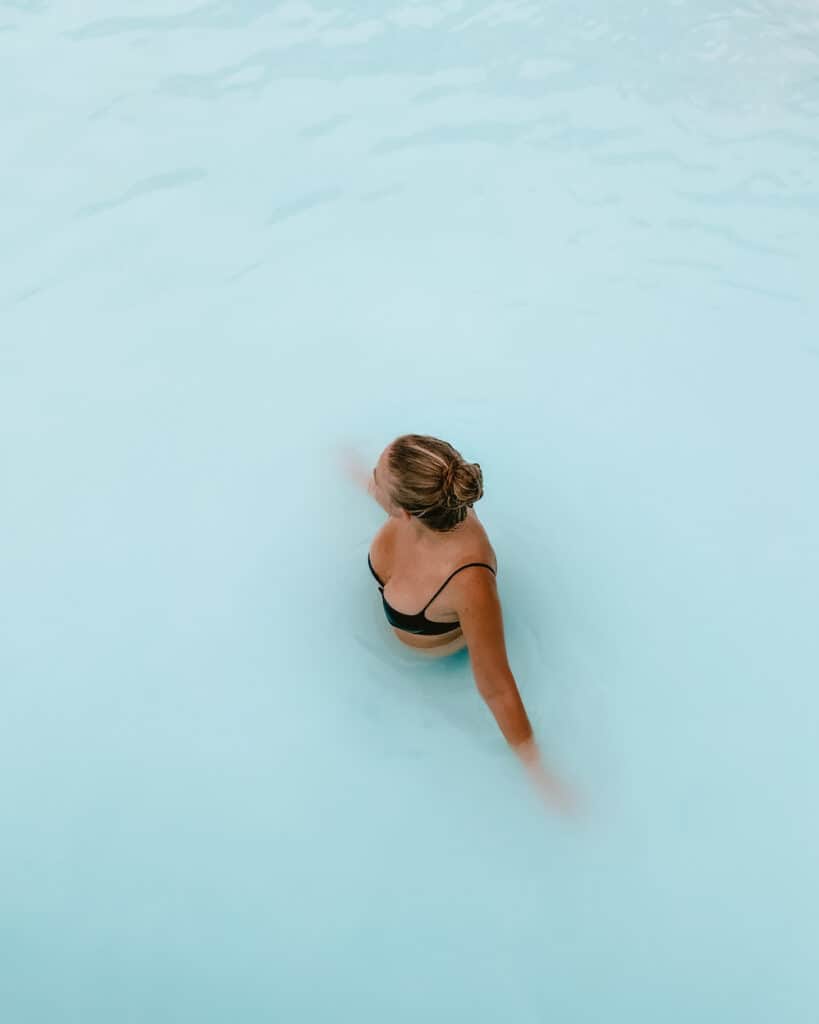
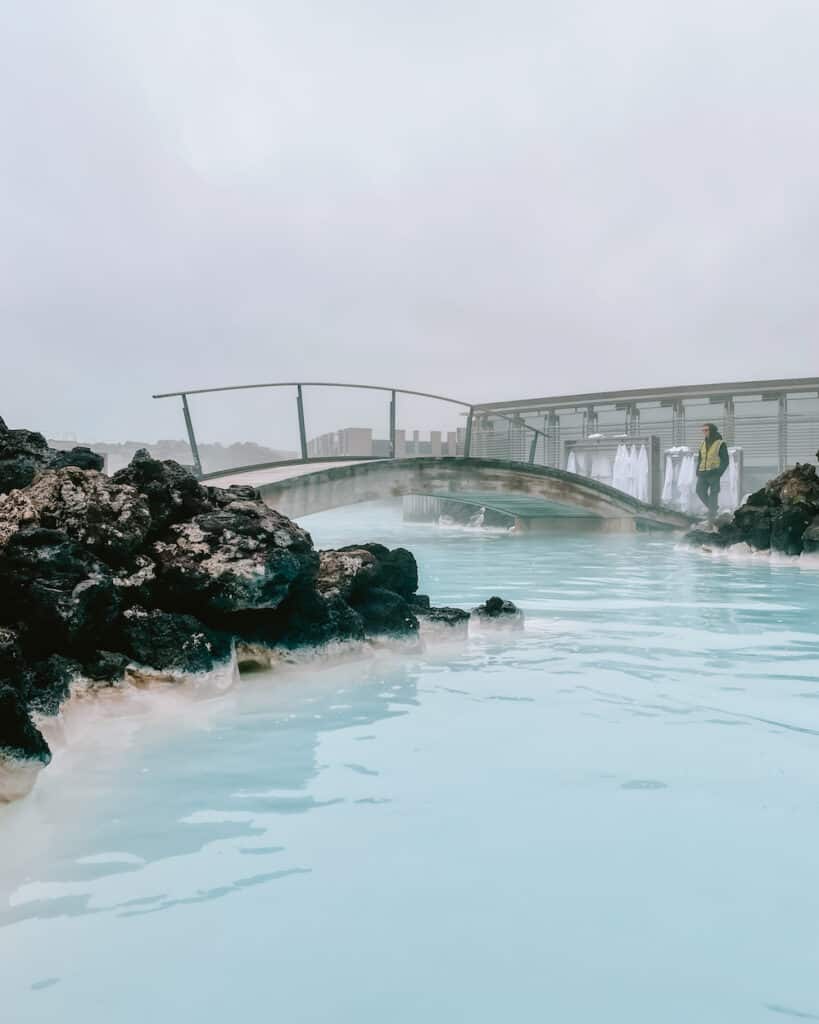
After grabbing our rental car, we headed straight to the Blue Lagoon for a few hours of soaking. The Blue Lagoon is a geothermal spa that’s located very close to the airport.
Entrance to the Blue Lagoon costs about $68 per person – it’s definitely not cheap but we felt like it was worth it! Your entrance includes locker rental, a free face mask, and a free drink at the swim up bar.
Make sure you reserve your ticket ahead of time. Time slots fill up quickly and the Lagoon can sometimes be booked up for weeks in advance.
If you’re not renting a car, I highly recommend booking transportation to the Blue Lagoon from the airport. It feels SO good to soak in the thermal waters after a long flight.
Grocery Shopping and Checking Into Airbnb
After our soak in the Blue Lagoon, we made a quick stop at the grocery store. If you’re traveling Iceland on a budget,
I highly recommend getting groceries at Bónus. There are 31 locations across Iceland and the prices are super reasonable compared to other stores.
Once we were stocked up on food, we checked into our Airbnb in Reykholt. We settled in, took a long nap, and then took off to explore a little bit along the Golden Circle.
Gullfoss

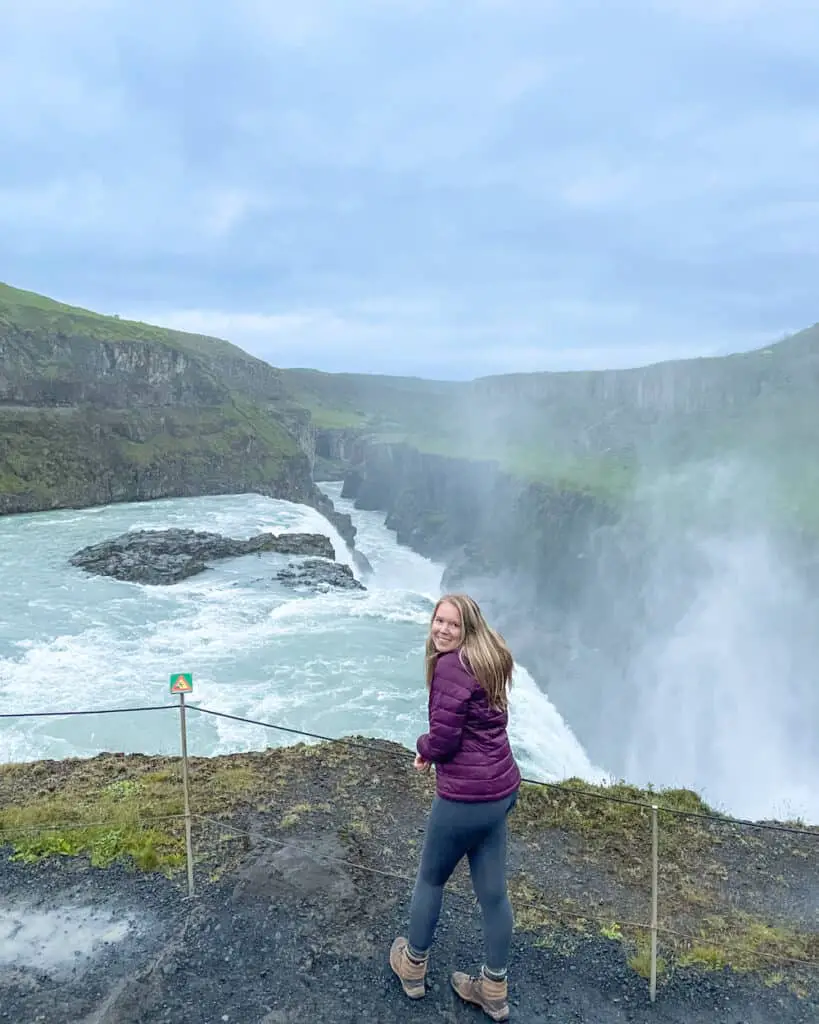
The Golden Circle is a 300km (186 mile) drive in Southern Iceland that contains 3 super popular attractions – Gullfoss waterfall, Geysir Geothermal Area, and Þingvellir National Park.
Our Airbnb was located right off the main road on the Golden Circle so it was a great base for seeing the area.
On our first night we visited Gullfoss and the Geysir Geothermal Area.
Gullfoss is a waterfall located inside of a large canyon. There is a large parking lot, a souvenir shop, and a very accessible trail going down to the falls area.
Geysir Geothermal Area
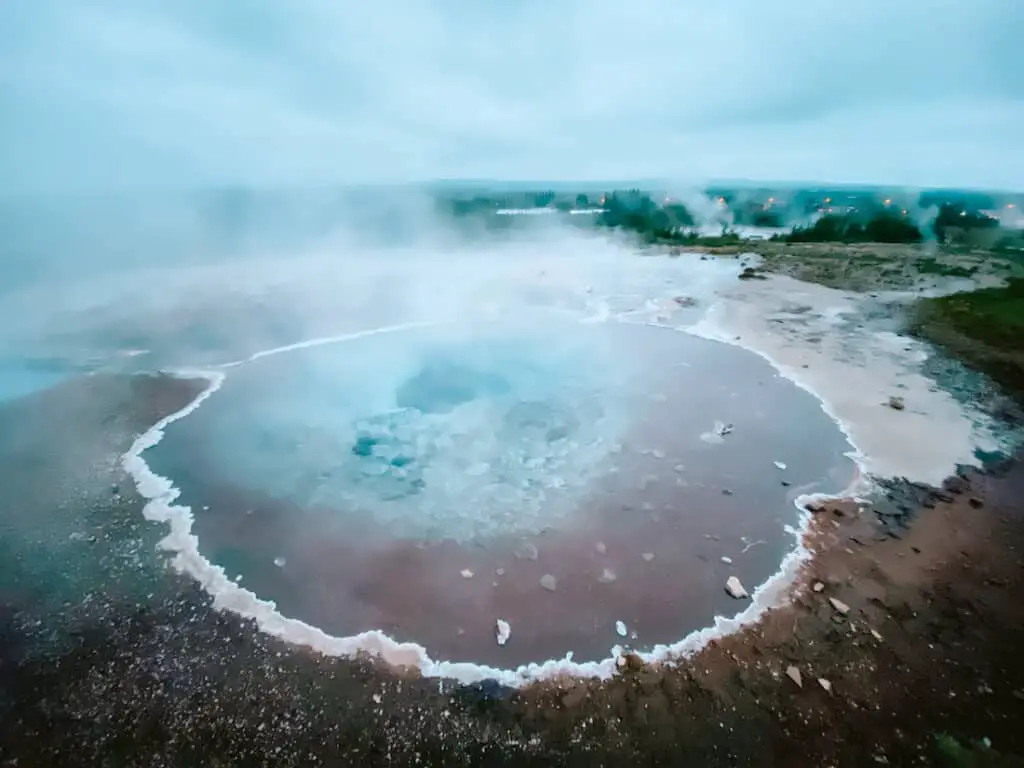
After Gullfoss, we decided to check out the Geysir Geothermal Area. These two attractions are only a 10 minute drive apart, so it was super easy to see them both on our first night.
The Geysir Geothermal Area consists of several hot pools, thermal vents, and spouting springs.
The most famous attraction here is Strokkur, which goes off every few minutes. It spews water up in the air sometimes as high as 40 meters, but usually it’s closer to 10-20 meters.
Day 2: Reykjavik And Waterfalls
Downtown Reykjavik
On our second day in Iceland, we decided to check out downtown Reykjavik.
We started out with a quick visit to the famous Hallgrimskirkja Church. The architecture of this church is so unique and stunning, and it can be seen from all over downtown Reykjavik.
We just checked it out from the outside, but you can pay around $7 to go inside and see the view from the top.
After that, we walked around downtown and popped into a few shops. We grabbed coffee and a snack at Cafe Babalu, got some ice cream at Valdis, and took a stroll through the surrounding neighborhoods.
Skógafoss Waterfall
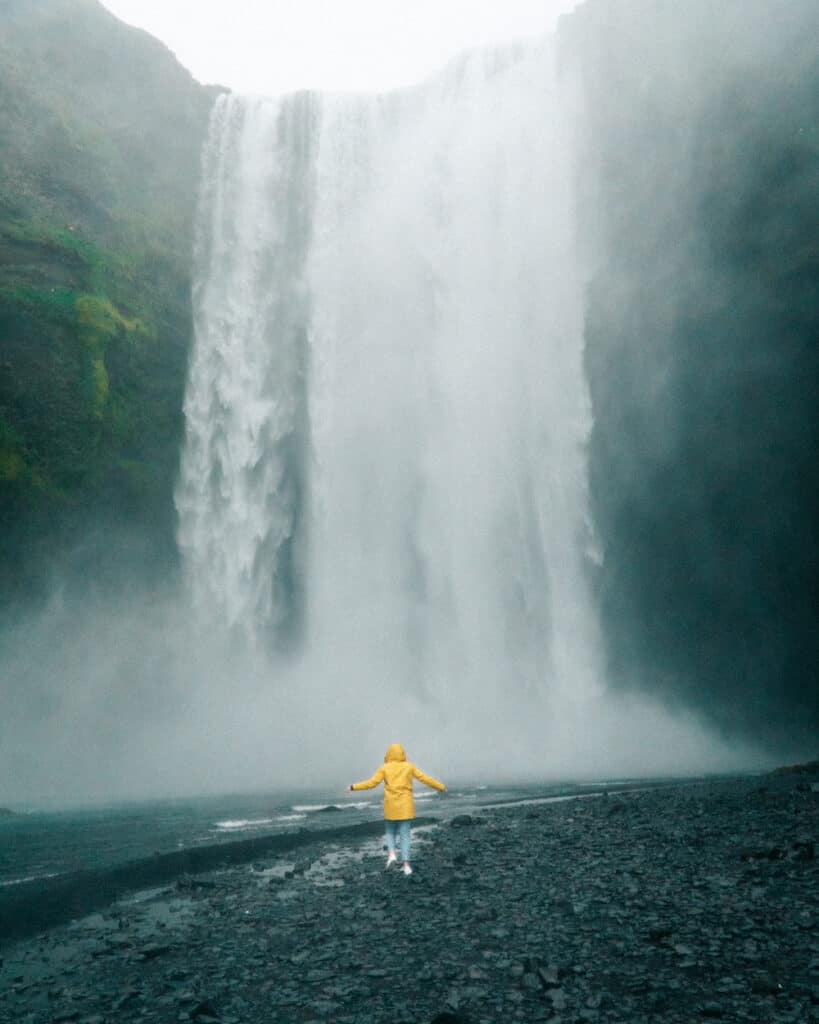
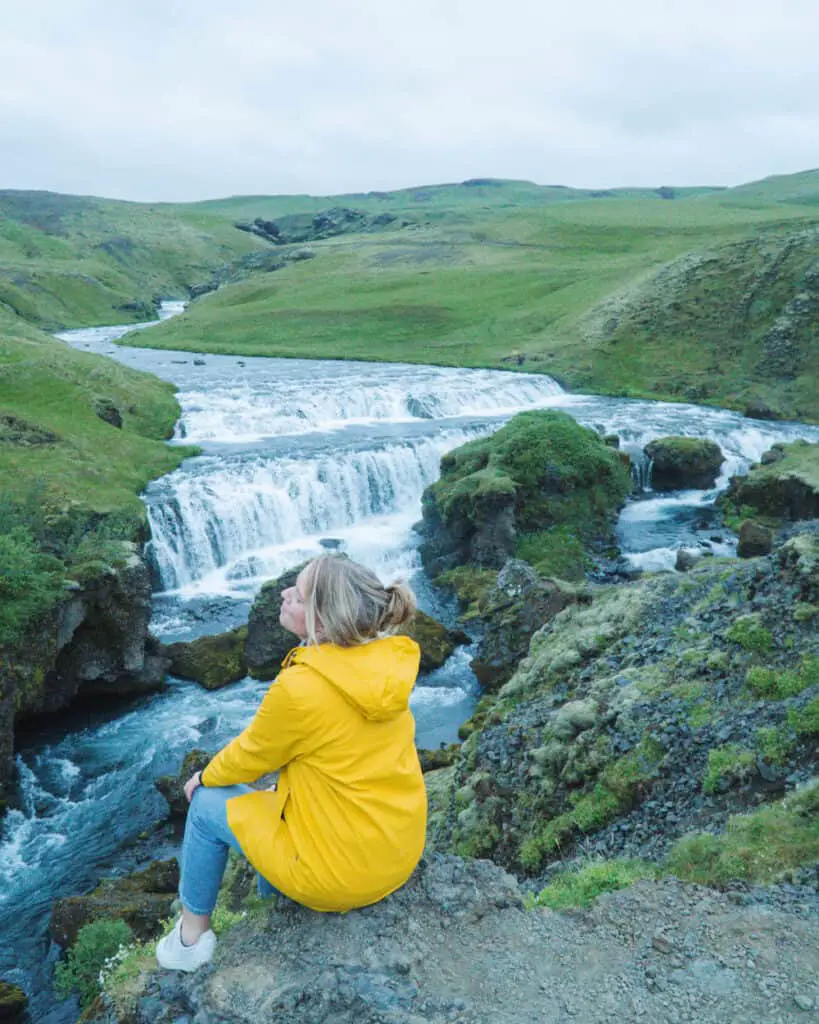
Once we had explored Reykjavik, we headed out to see some waterfalls.
Our first stop was at the super famous Skógafoss waterfall. This is one of the biggest waterfalls in Iceland, with a height of around 60 meters and a width of 25-30 meters.
You can walk right up to the falls, but be aware that you may get soaked! The guys ran right up to the waterfalls and then the wind changed and they got absolutely blasted with water.
After checking out the falls from below, be sure to get a view from the top. There’s a set of stairs to the right of the Skógafoss that take you up to a viewing platform.
Once you get to the viewing platform, you have the option to keep going along the trail and hike along the incredible Waterfall Way trail.
The entire trail is 16km (10 miles) roundtrip if you’re feeling very adventurous. If you take the full hike, you’ll see more than 25 waterfalls, lush green landscape, and plenty of beautiful canyon views.
We knew we wanted to visit some other waterfalls, so we only walked the trail for about a mile and then turned back.
Even though we didn’t do the full trail, we still saw plenty of amazing views and several waterfalls.
Want to visit Skogafoss? Check out my full post about how to visit this beautiful waterfall in Iceland.
Gljufrabui and Seljalandsfoss Waterfalls

Just a half hour drive from Skógafoss you’ll find two more beautiful waterfalls right next to each other – Gljufrabui and Seljalandsfoss.
We chose to check out Gljufrabui waterfall first. This waterfall is actually hidden behind a cliff, so it’s overlooked by most travelers.
To get to this waterfall, you’ll have to wade through a narrow canyon for a few meters. Depending on the weather, you may get a little wet on your way in.
Once you’re inside, you’ll have incredible views of the misty waterfall, moss-covered walls, and the open sky above. There’s also a large boulder that you can climb for some pretty epic pictures.
A quick 10 minute walk from Gljufrabui takes you to the famous Seljalandsfoss waterfall.
This was actually one of our favorite waterfalls in Iceland because you are able to walk behind the falls.
Be aware that you do have to pay to park at Seljalandsfoss. The fee is 800 ISK (about $6) and allows you to park all day. This fee also allows you to access the bathrooms next to the parking lot.
Day 3: Snæfellsnes Peninsula
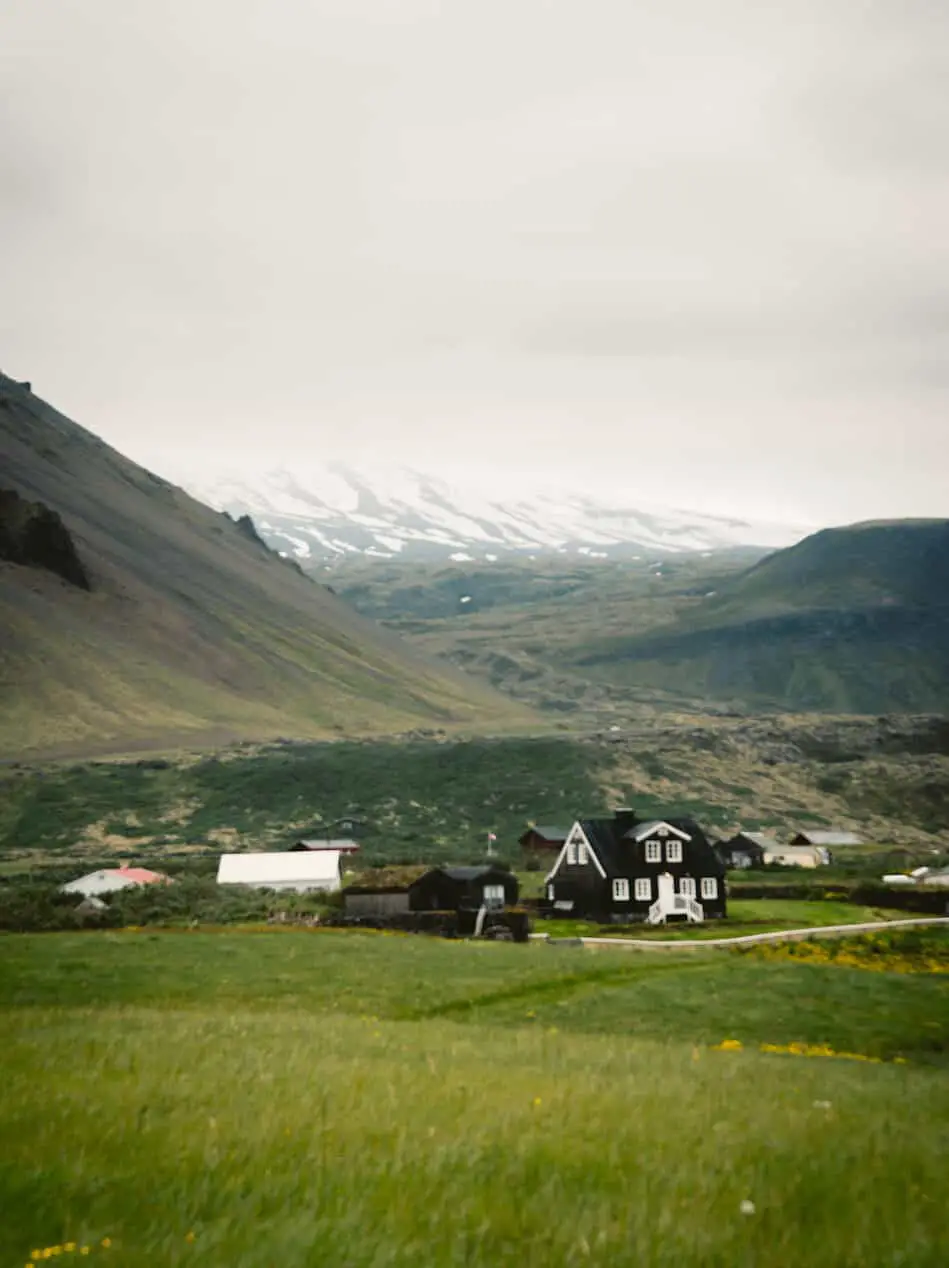
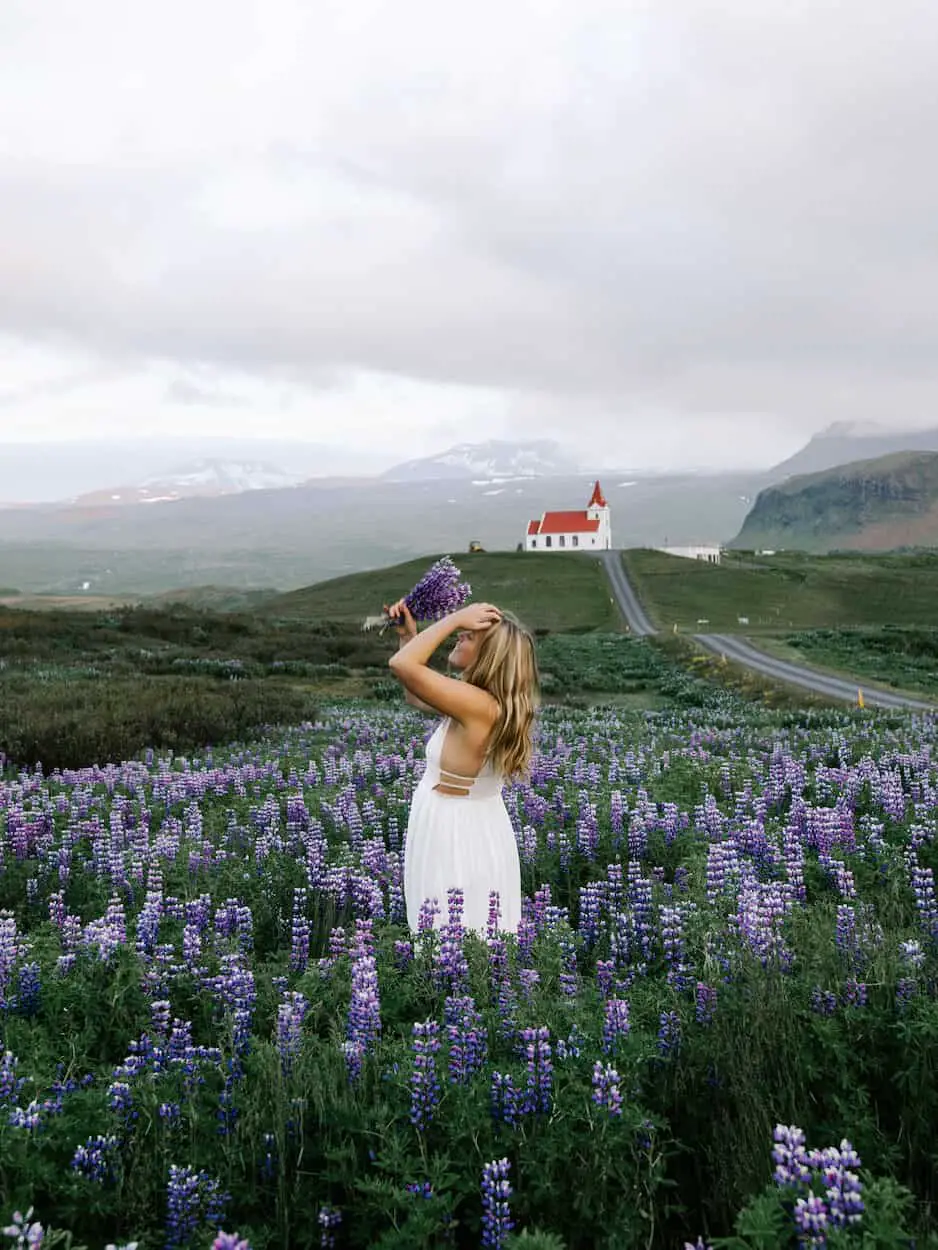
On our third day in Iceland we made our way over to the Snæfellsnes Peninsula. This peninsula is located in western Iceland and takes about 2.5 hours to reach from the Reykjavik area.
The Snæfellsnes Peninsula is often referred to as “Miniature Iceland” because it contains all of the landscapes that Iceland is famous for – volcanoes, lava fields, hot springs, black sand beaches, fjords, and even a glacier.
I definitely recommend spending at least one day exploring this insanely gorgeous peninsula.
Arnarstapi
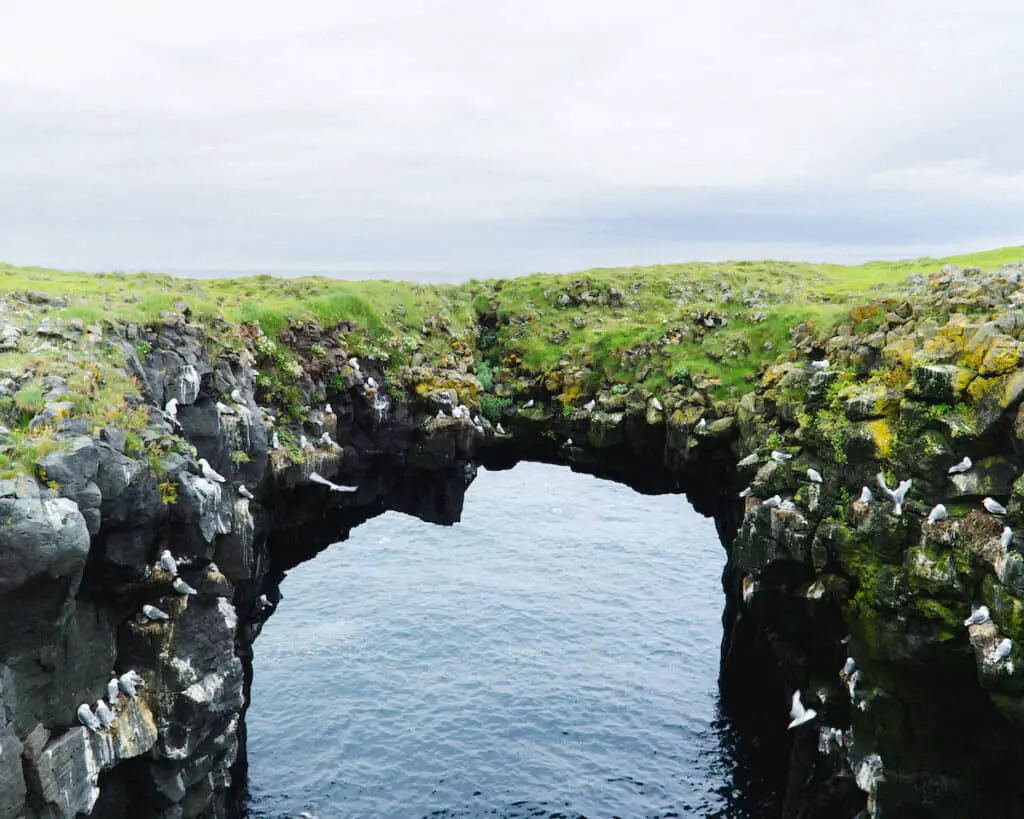
Our first stop was the small town of Arnarstapi. We took a walk along the coastal cliffs and admired the lava formations and grassy cliffs.
The main reason for visiting Arnarstapi was to see the stone bridges. Keep in mind that there are two stone bridges here – one you can walk out on and one that’s further out into the sea.
When walking along the coast, you’ll reach the further stone bridge first.
Keep walking down the path and you should come across the second stone bridge that is safe to walk out on.
Ingjaldsholskirkja Church
Next, we made our way over to the Ingjaldsholskirkja Church. This is one of the lesser-known churches in Iceland, but it’s definitely worth stopping at.
In summer, the fields in front of the church are covered with lupines.
The view of the purple fields, the white and red church, and the snow-capped mountain in the background felt like we were in a painting.
Kirkjufellsfoss Waterfall
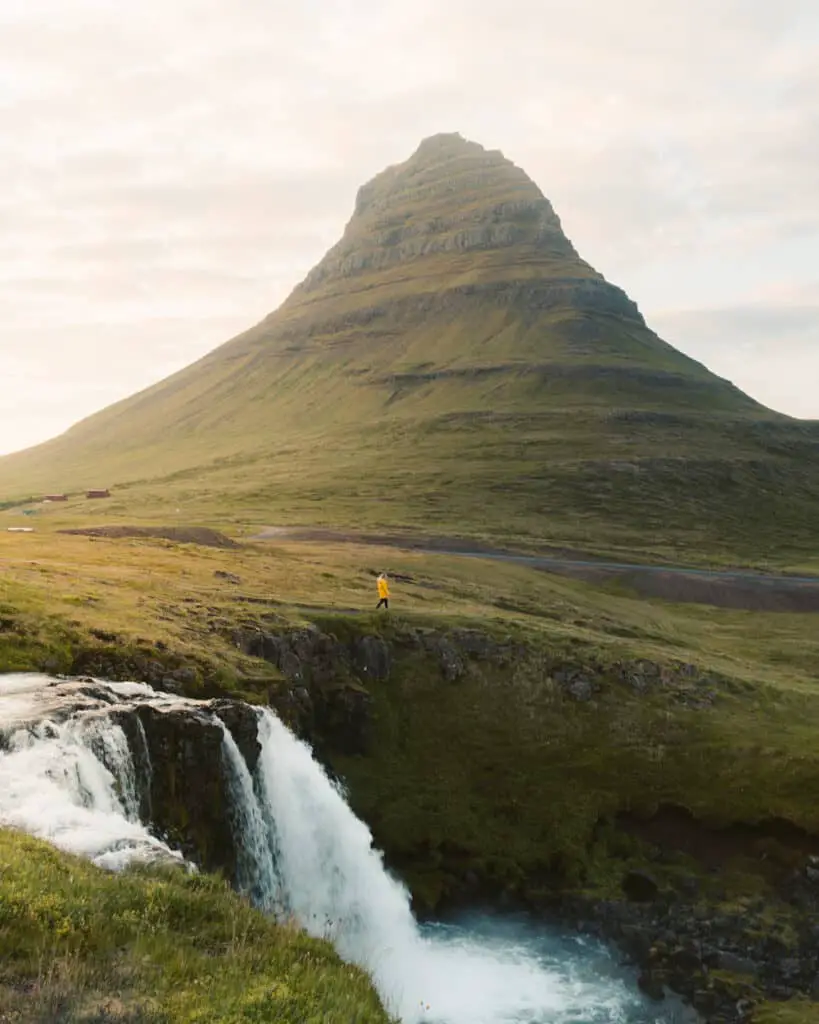
Our last stop on the Snæfellsnes Peninsula was the iconic Kirkjufellsfoss waterfall and mountain.
Kirkjufell is a green mountain that has come to be known as a symbol of Iceland. There is a waterfall in front of the mountain called Kirkjufellsfoss.
This spot is super popular with photographers year round, so expect to share the view with at least a few other tourists.
We visited at midnight and there were about 15 other people there enjoying the view.
Other Things To Do In The Snæfellsnes Peninsula
There’s SO much to do in the Snæfellsnes Peninsula and we only scratched the surface.
Here are some things to do in this area of Iceland that I would add to my list for next time:
- Snæfellsjökull National Park: A national park that features a glacier situated at the top of a volcano.
- Djupalonssandur Black Sand Beach: A beautiful beach featuring black sand and pebbles.
- Stykkishólmur: The largest town on the Snæfellsnes peninsula. It’s a popular jumping off point for ferry rides to the nearby fjords. This town was also featured in the popular movie ‘The Secret Life of Walter Mitty’.
- Búðir Church: A super photogenic black church.
If you’re visiting Iceland without a car, I highly recommend taking a day trip to the Snæfellsnes Peninsula with a guide.
There’s SO much to see in this area, and having a guided tour will really help you see all of the highlights.
Day 4: Kerid Crater And Hrunalaug Hot Springs
Friðheimar Tomato Restaurant
On day four of our 7 days in Iceland we started off with lunch at Friðheimar. It’s a highly-recommended restaurant inside of a tomato greenhouse on the Golden Circle.
Luckily for us, Friðheimar was located just a few minutes down the road from our Airbnb.
We didn’t really know what to expect but the dining experience blew us away. Our table was right next to a huge wall of beautiful hanging tomato vines.
The wait staff gave us a brief history of the restaurant and greenhouse before we ordered our food.
I’m not a huge tomato fan, but the food was incredible. I opted for the all-you-can-eat soup and bread buffet.
I got unlimited tomato soup and various breads for about $20. We also tried the tomato beer and the Bloody Mary cocktails.
This restaurant gets very busy, so it’s highly recommended to make a reservation ahead of time. Check out available times on their website.
After your meal, make sure to say hi to the Icelandic horses outside (but please don’t feed them!)
Kerid Crater
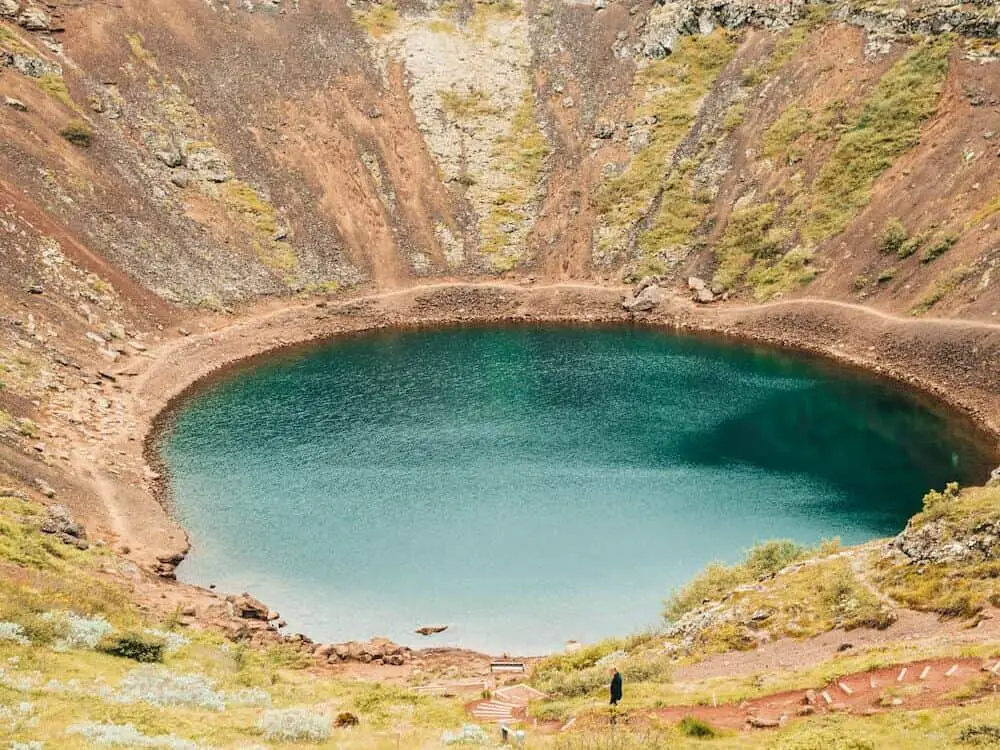
After lunch, we stopped by the Kerid Crater. This volcanic crater is also located on the Golden Circle, but it’s much less popular than the other famous attractions.
We really enjoyed walking around the top rim of the crater, as well as going down the trail to the crater lake.
To be honest, I wouldn’t go out of my way to go back to this attraction, but it’s definitely worth a stop if you’re already in the area.
There is a small entrance fee of about $3.20 that goes towards preserving and protecting the area.
Hrunalaug Hot Springs
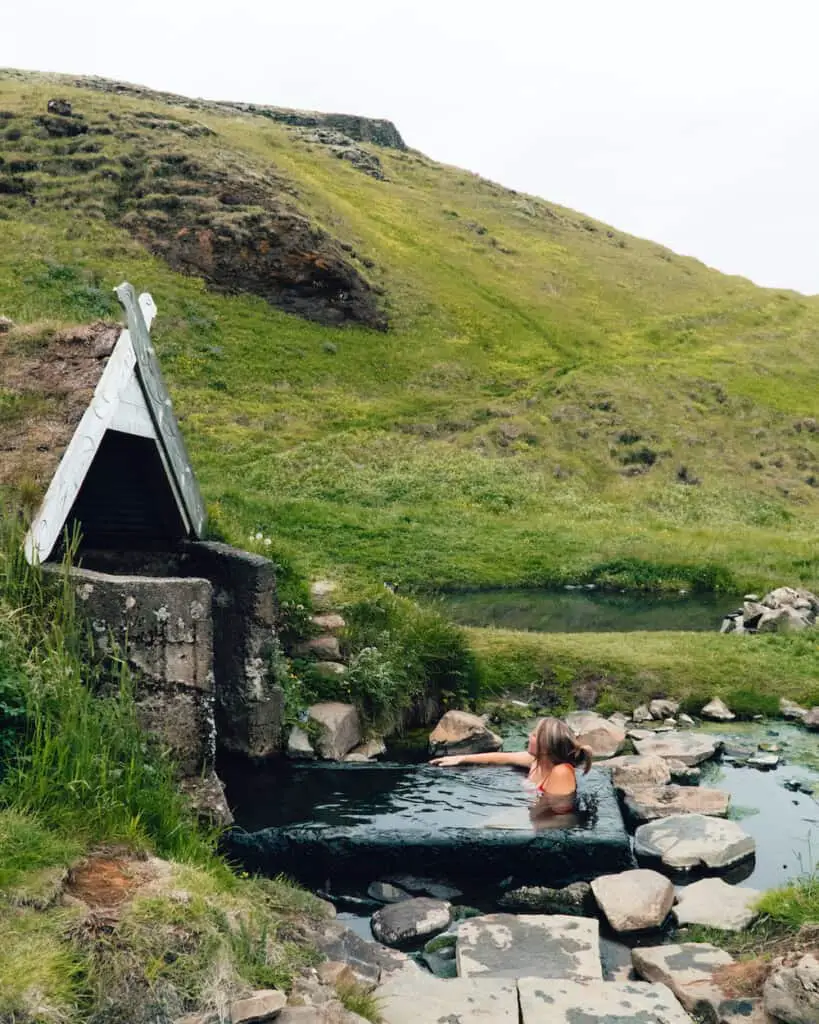
Later that night, we took a dip in Hrunalaug Hot Springs. This low-key spot attracts far fewer visitors than other hot springs in Iceland, but it’s just as beautiful!
Hrunalaug is located just a few minutes off the Golden Circle road, near the town of Fludir.
There are a few different soaking pools here, including a rectangular hot pool, a shallow warm pool, and one small tub that is actually an old feeding trough for sheep.
The long rectangular pool is definitely the hottest of the three pools, and it’s usually the most crowded. The small tub is colder but it is the prettiest location for photos.
These hot springs cost 1000ISK ($7.50) to visit. There is a small dropbox where you can leave your cash if the land owner is not there to collect the entry fee.
PLEASE pay the fee even if the owner is not there. This money goes towards maintaining the land and supporting the local farmer who owns it.
Day 5: Jökulsárlón Glacier Lagoon And Diamond Beach
On our fifth day in Iceland we visited the Jökulsárlón Glacier Lagoon and Diamond Beach.
This was a 4 hour drive from our Airbnb so we broke up the drive with a stop at Systrakaffi for lunch. I highly recommend this spot for lunch or dinner if you’re in the area!
Jökulsárlón Glacier Lagoon
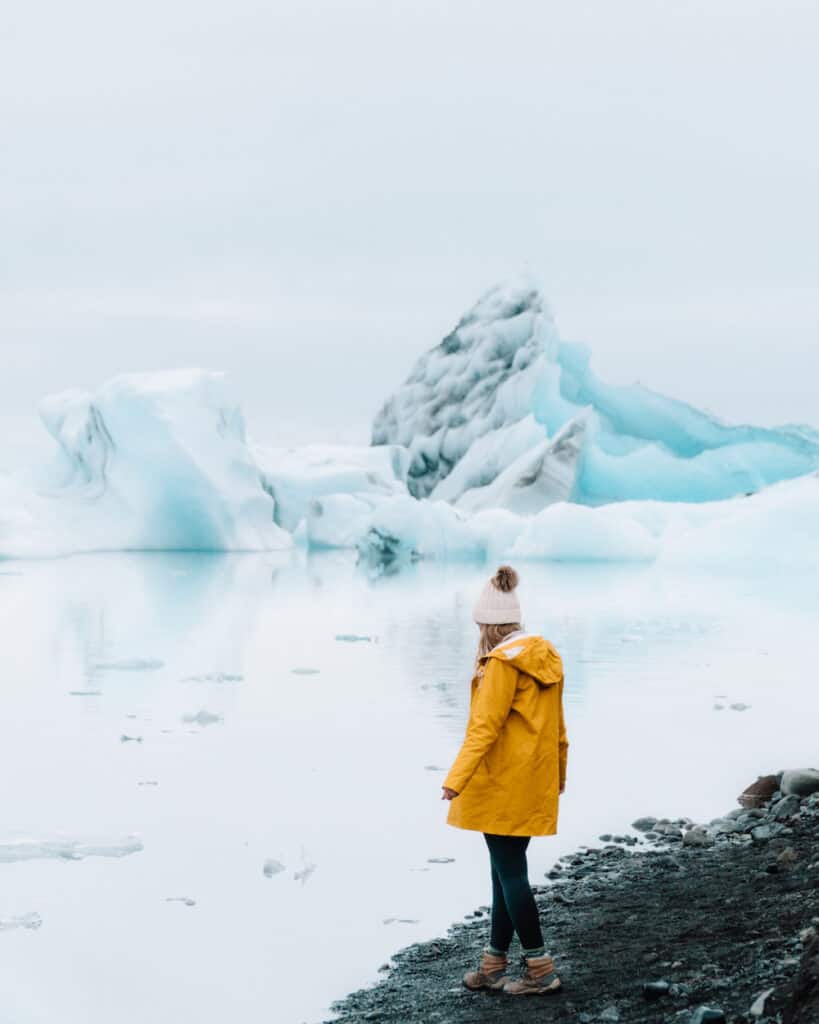
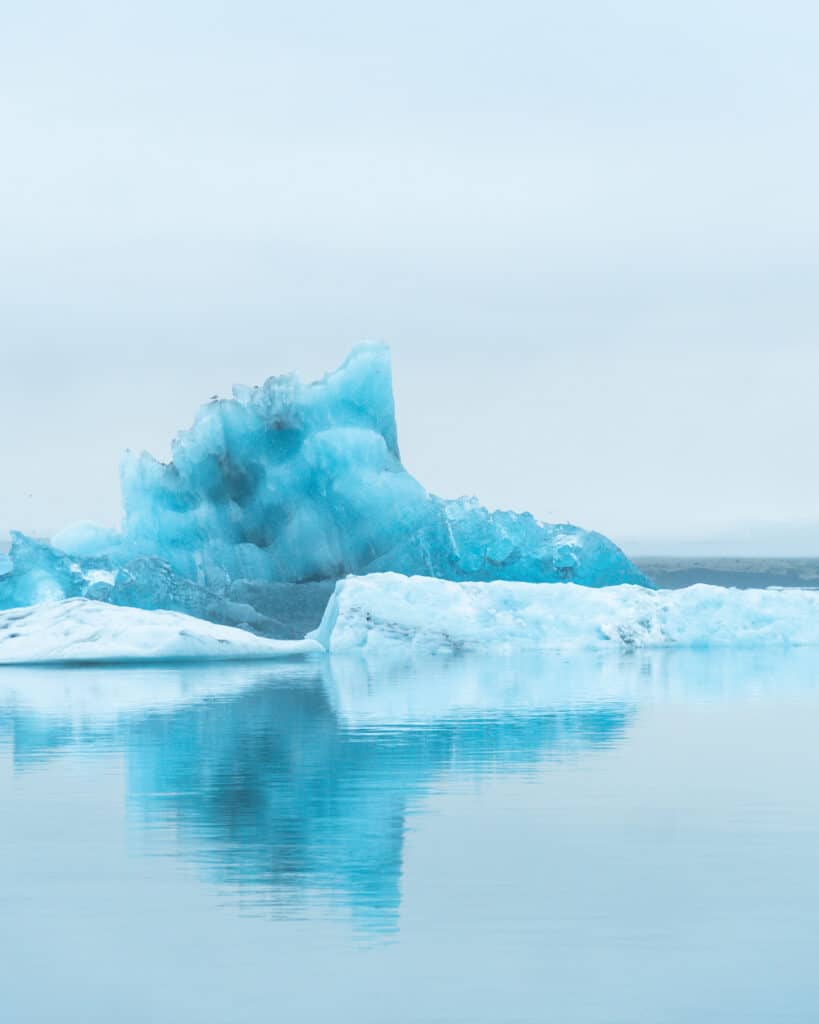
Our first stop of the day was the Jökulsárlón Glacier Lagoon. This lagoon is filled with free-floating icebergs that have broken off of nearby Breiðamerkurjökull Glacier.
As Breiðamerkurjökull shrinks in size due to global warming, Jökulsárlón Lagoon will keep on growing. This means that the lagoon will look a bit different every time you visit!
Although it takes over 5 hours to get here from Reykjavik, it is definitely worth visiting.
The glacier lagoon is one of the most stunning natural features in Iceland. The drive to get to Jökulsárlón is also stunning, with views of waterfalls, volcanoes, and beaches along the way.
The glacier lagoon is free to visit, but you do have the option of taking a boat trip while you’re there. The boats run from April to October when conditions allow, and they allow you to get up close and personal with the glaciers.
If you’re visiting in winter, you can take a tour of the Ice Caves at nearby Vatnajökull Glacier.
This naturally-formed ice cave is absolutely stunning and looks different every year due to differing glacial melt patterns.
Diamond Beach
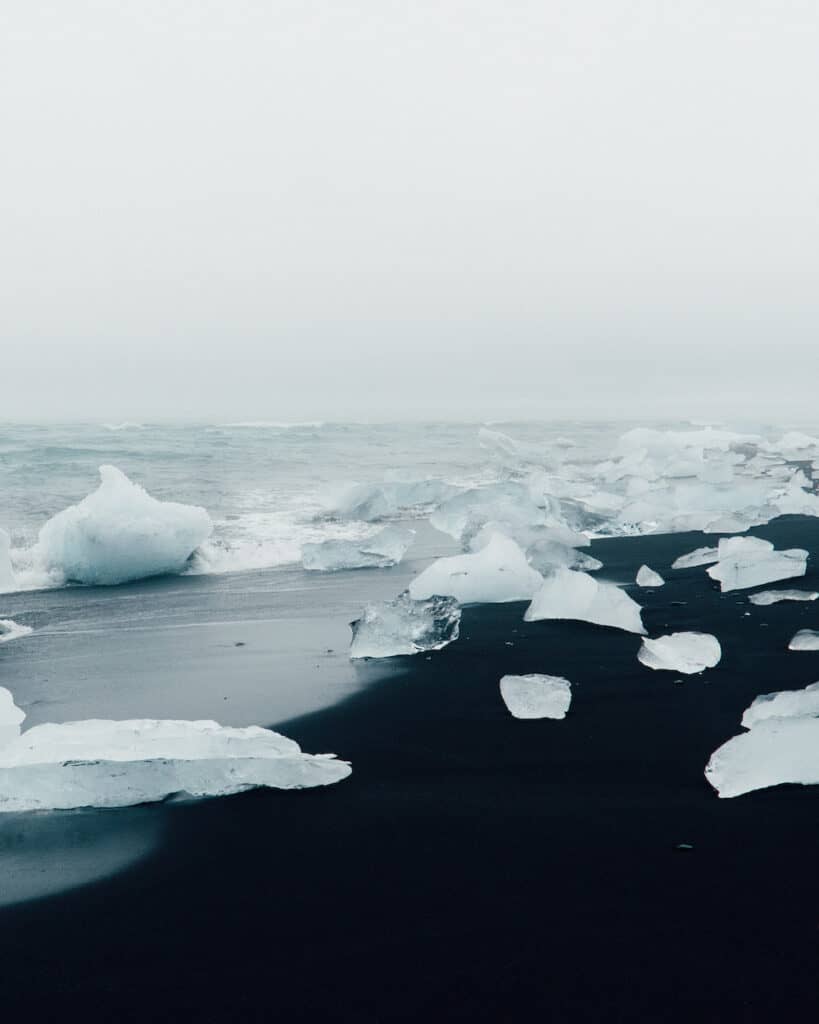
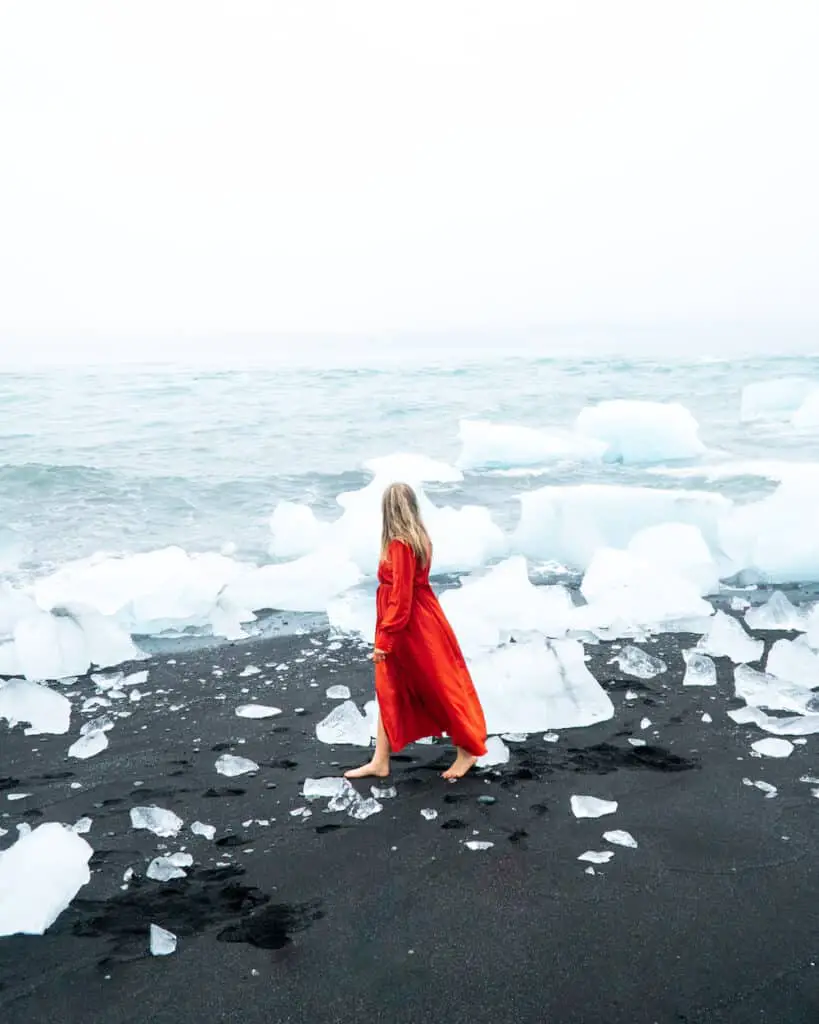
Across the street from Jökulsárlón is the famous Diamond Beach. This beach gets its name from the polished glacial fragments that wash up on shore.
The ice chunks, set against the jet-black sand, look like diamonds in the sunlight.
Although the beach is fairly small, it’s absolutely worth visiting. Aside from being a stunning view, it’s also a great place to spot Icelandic seals and Orca whales.
Day 6: Vík, Reynisfjara Beach, And Dyrhólaey Viewpoint
On our last full day in Iceland, we explored Vík and the surrounding areas.
Vík is located about two and a half hours from Reykjavik and is famous for its black sand beaches, stunning wooden church, and beautiful cliffs where you can spot puffins.
Skool Beans Cafe
We started off our day with mochas at Skool Beans Cafe. This cafe is super unique because it’s actually located inside of a converted school bus.
The drinks were incredible, the staff were all SO nice, and the atmosphere was insanely cozy. I highly recommend coming here if you’re spending any time in Vík!
They’re open from 9am to 5pm on Tuesdays – Fridays, and 10am – 5pm on weekends. Closed on Mondays!
Vík i Myrdal Church
After we sipped our mochas, we made our way up to the quaint little wooden church overlooking the town.
This red and white church dates back to 1873 and is the first thing you see when you drive into Vík.
I highly recommend driving or walking up to the Vík i Myrdal church if you’re visiting Vík.
The church itself is incredibly photogenic, but the views while you’re there equally beautiful. You’ll have a panoramic view of the cliffs, beach, and town of Vík from the parking lot.
I also recommend walking up to the graveyard behind the church while you’re there.
It’s a short but steep trek to the top and you get an even better view of the surrounding area.
Reynisfjara Beach
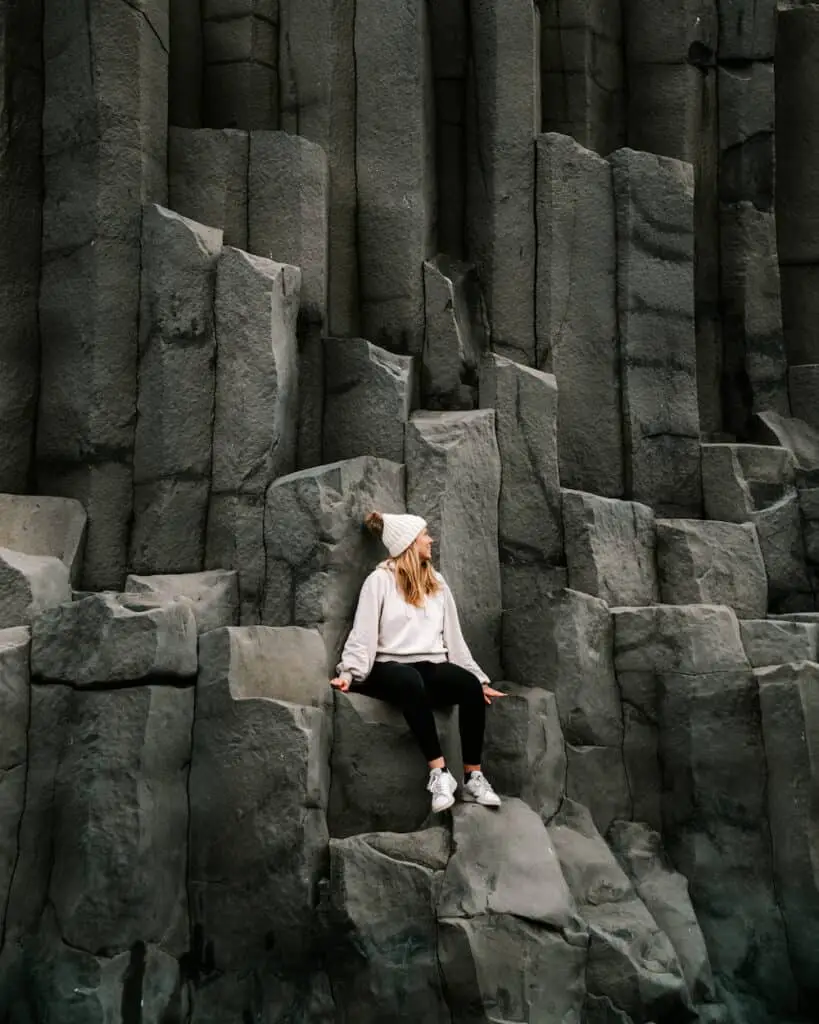
You’ve probably already seen pictures of this stunning black sand beach in Iceland. It’s the most famous on the island due to the dramatic basalt columns that formed at the end of the beach.
You can easily access Reynisfjara Beach from the main road in Vík.
I definitely recommend taking a walk along the black sand beach and taking a picture at the basalt columns.
One thing to be aware of at this beach is that it’s notorious for sneaker waves.
These unexpected waves can be deadly and it’s almost impossible to know that they’re coming. Keep your distance from the water and make sure that you keep an eye on little ones if you’re visiting Iceland with children.
Dyrhólaey Viewpoint
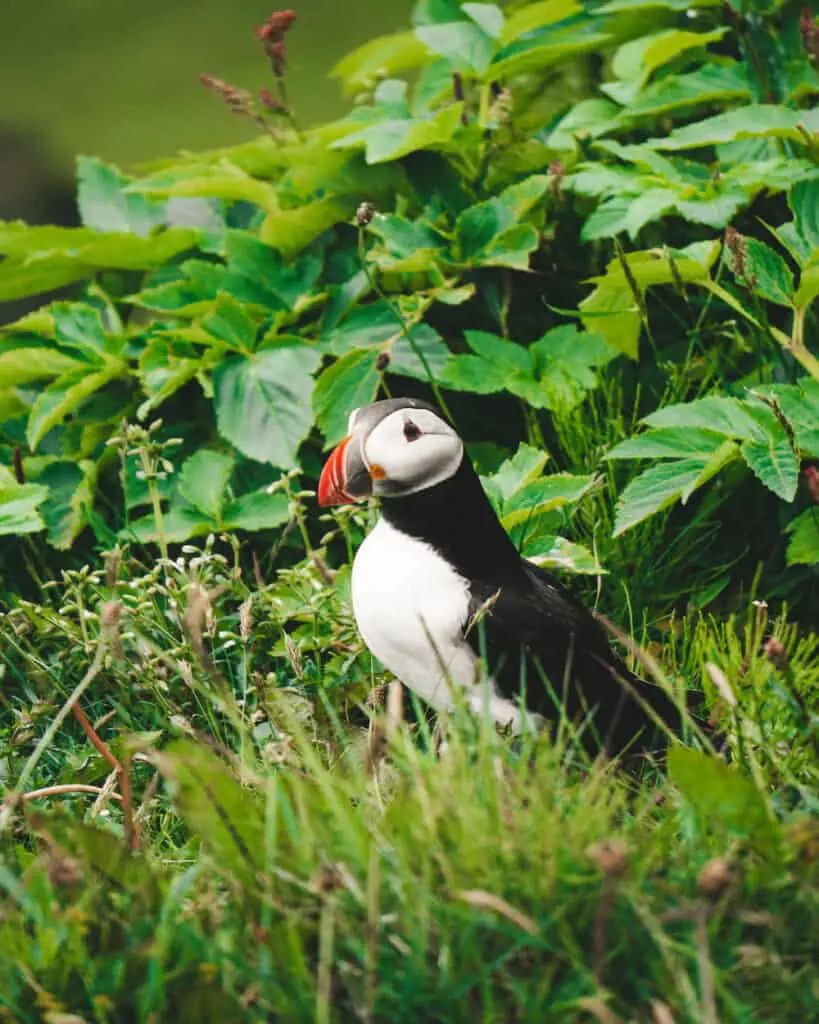

One of the highlights of our one week in Iceland was spotting puffins at Dyrhólaey Viewpoint. This small peninsula is located at the edge of Vík i Myrdal.
You’ll head to the top of the viewpoint near the lighthouse and park your car there.
From the parking lot, walk out along the marked trail and enjoy the panoramic views of the beaches and surrounding sea cliffs.
If you’re visiting Iceland in summer, you may be lucky enough to spot some puffins at this viewpoint.
April through August is the best time to see puffins in Iceland, according to various Iceland guides. We visited in July and saw tons of them!
At Dyrhólaey you’ll have the best chances of spotting puffins if you go early in the morning or late in the afternoon.
Puffins spend their days out at sea catching fish, so it’s best to spot them before they’ve left for the day or when they’re returning back at night.
You’ll have the best chances if you visit around 6am-9am or 7pm-10pm during the summer. We visited around 7pm and saw lots of puffins returning back to their nests after a day of fishing.
Day 7: Packing And Flying Home
Our 7th day in Iceland was spent packing, cleaning our Airbnb, and dropping off our rental car.
If we had had more time this day, we probably would have gone for round two at the Blue Lagoon or explored Reykjavik a bit more.
Useful Things To Know About Iceland
Now that you have an epic itinerary for exploring Iceland, let’s go over some things you need to know before you visit.
Weather
The weather in Iceland can be very unpredictable.
Depending on the time of day and where you are in the country, you could experience rain, sunshine, snow, or fog.
Some days we experienced all of these within a few hours of each other!
I recommend always wearing layers when you’re exploring in Iceland. This allows you to add or remove clothing items as needed throughout the day.
When we visited in summer, the temperatures ranged from 40°F to 70°F throughout the day. During winter you can expect a range of 10°F to 35°F.
I have a full post about the weather in Iceland in summer and what you can expect if you visit during the summer months.
Currency
Iceland uses the Icelandic Króna (ISK). At the time of writing, $1 USD is the equivalent of $129.47 ISK.
We rarely had any use for cash during our time in Iceland. 99% of places we visited accepted contactless card payments or Apple Pay.
The only time we needed physical currency was when we visited Hrunalaug Hot Springs and for a few random bathroom visits.
Northern Lights And Midnight Sun
There are two natural phenomenons in Iceland that occur in different seasons.
If you are interested in seeing the Northern Lights, you will need to visit Iceland in the winter months. September through April are the ideal months to spot the Aurora Borealis.
From May to August the sky does not get dark enough for the Northern Lights to be visible.
Instead, you’ll experience the phenomenon known as the Midnight Sun season. This is when the sun never fully sets or only sets for a very short amount of time at night.
We visited Iceland in July to experience the Midnight Sun. The sky would get darker around midnight but the sun never fully set.
On clear days, the sunset would last for hours. It was a really remarkable thing to experience and the longer days meant we could explore a lot more.
Cuisine
If you are interested in sampling the local cuisine while you’re in Iceland, be prepared to consume a lot of fish-based food.
Seafood is very common throughout the country. You’ll also encounter a lot of lamb, hot dogs, and skyr (a type of yogurt).
If those dishes don’t sound appealing to you, don’t worry. You’ll find plenty of international restaurants in the bigger cities like Reykjavik and Akureyri.
We also found that Iceland was very vegan and vegetarian friendly. Most restaurants had veggie dishes on the menu – even the little cafes in the middle of nowhere.
What To Pack
What you pack for Iceland will depend heavily on the season you visit in.
But here are some all-season essentials that you should pack no matter when you visit:
- Rainproof and Windproof jacket – the weather in Iceland is unpredictable. Expect at least a few rainy and windy days throughout your visit.
- Swimsuit – while you won’t be swimming at any of the beaches, you may want to take a dip in some of the hot springs in Iceland.
- Sturdy walking shoes or hiking boots – You will likely be spending a lot of time in the outdoors during your trip. Make sure you have sturdy shoes or boots with a good tread/grip.
- Reusable water bottle – the tap water in Iceland is super clean and safe to drink. Bring a reusable water bottle to save money and reduce your plastic use while you visit.
- Plenty of layers – no matter what season you visit in, you’ll want to pack some high quality base layers. The weather can change quickly so it’s nice to be able to add or remove clothing as needed.
- Nicer outfit – if you plan on spending time in Reykjavik, you may want to pack a nicer outfit for grabbing food at a restaurant or experiencing the city’s nightlife.
- Packable backpack – this is one of my top travel essentials for any trip. It’s always nice to have a smaller day bag for carrying around extra layers of clothing, snacks, cameras, etc.
This post was all about how to spend one week in Iceland.
You may also like:



